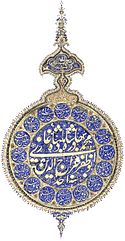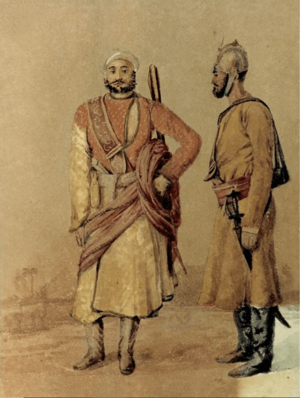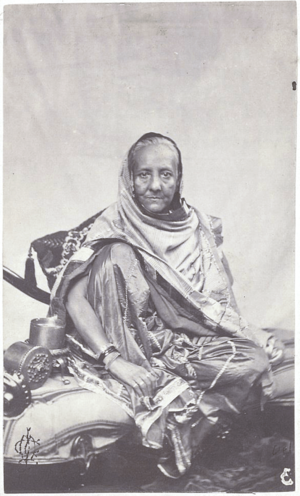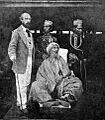Bahadur Shah Zafar facts for kids
Quick facts for kids Bahadur Shah II |
|||||||||||||
|---|---|---|---|---|---|---|---|---|---|---|---|---|---|
| King of Delhi Badshah Shahanshah-e-Hind |
|||||||||||||

Portrait of Bahadur Shah II, c. 1854
|
|||||||||||||
| 20th Mughal Emperor | |||||||||||||
| Reign | 28 September 1837 – 21 September 1857 | ||||||||||||
| Coronation | 29 September 1837 Red Fort |
||||||||||||
| Predecessor | Akbar II | ||||||||||||
| Successor | Empire abolished (Victoria as Empress of India) |
||||||||||||
| Born | 24 October 1775 Shahjahanabad, Mughal Empire (present day Old Delhi, India) |
||||||||||||
| Died | 7 November 1862 (aged 87) Rangoon, Burma Province, British India |
||||||||||||
| Burial | 7 November 1862 Rangoon, Burma |
||||||||||||
| Spouse |
|
||||||||||||
| Issue |
|
||||||||||||
|
|||||||||||||
| House | House of Babur | ||||||||||||
| Dynasty | |||||||||||||
| Father | Akbar Shah II | ||||||||||||
| Mother | Lal Bai | ||||||||||||
| Religion | Sunni Islam (Hanafi) | ||||||||||||
| Royal Seal |  |
||||||||||||
| Military career | |||||||||||||
| Battles/wars | Indian Rebellion of 1857 | ||||||||||||
Bahadur Shah II, often called Bahadur Shah Zafar (which means "Victory"), was the last Mughal Emperor of India. He was born Mirza Abu Zafar Siraj-ud-din Muhammad on October 24, 1775. He was also a well-known Urdu poet.
He became emperor on September 28, 1837, after his father, Akbar II, passed away. By this time, the Mughal Empire was very small. Bahadur Shah Zafar's power was mainly limited to the walled city of Old Delhi. After the Indian Rebellion of 1857, the British sent him away to Rangoon in British-controlled Burma in 1858.
Bahadur Shah Zafar was not his father's first choice to be the next emperor. His father, Akbar II, was held by the British. One of Akbar Shah's queens wanted her son, Mirza Jahangir, to be the next ruler. However, the East India Company sent Jahangir away after he attacked one of their officials. This made it possible for Bahadur Shah to become emperor.
Contents
Bahadur Shah II: The Last Mughal Emperor
His Time as Emperor
When Bahadur Shah Zafar became emperor, the Mughal Empire had shrunk a lot. It was only the city of Delhi and the area around it. Other parts of India that were once under Mughal rule had either been taken over by the Maratha Empire or had become independent kingdoms.
The East India Company became very powerful in India during the 1800s. The emperor was respected by the Company, and they gave him money. He allowed them to collect taxes in Delhi and keep soldiers there. Zafar himself was not very interested in ruling or having a big empire. He was later sent away from Delhi after the Indian Rebellion of 1857.
A Poet and Sufi
Bahadur Shah Zafar was a famous Urdu poet. He wrote many Urdu ghazals, which are a type of poem. Some of his poems were lost during the 1857 rebellion, but many survived. They were put together in a collection called the Kulliyyat-i-Zafar.
His court was home to many famous Urdu scholars, poets, and writers. These included Mirza Ghalib, Daagh Dehlvi, Momin Khan Momin, and Mohammad Ibrahim Zauq. Zauq was also Bahadur Shah Zafar's teacher.
Bahadur Shah Zafar was a very religious Sufi. He was seen as a Sufi teacher and had many students. He believed that his position as both a Sufi teacher and emperor gave him special spiritual powers. He also believed in charms and good luck items. He would often ask Sufi teachers and Hindu astrologers for advice.
He showed that both Hinduism and Islam shared the same main ideas. His court celebrated many Hindu festivals like Rakhi, Holi, and Diwali. He also welcomed Shia Muslims back into the Mughal court.
The 1857 Rebellion
When the Indian Rebellion of 1857 began, rebel soldiers (called Sepoys) came to the Mughal Court in Delhi. Many Indian kings and soldiers accepted Bahadur Shah Zafar as the Emperor of India. This was partly because he was fair to all religions.
On May 12, 1857, Zafar met with the Sepoys. He asked them why they had come to him, as he had no way to support them. Bahadur Shah Zafar was unsure what to do. However, he agreed to the Sepoys' demands when they told him they could not win against the East India Company without him.
Some prisoners were killed in the palace, even though Zafar protested. The people who did this were not Zafar's supporters. They wanted to make it seem like he was involved. Once he joined the rebellion, Bahadur Shah II took responsibility for the actions of the rebels. Even though he was upset by the looting, he publicly supported the rebellion. Later, it was thought that Bahadur Shah was not directly responsible for the killings. However, he might have been able to stop them, so he was seen as agreeing to them during his trial.
The city's new administration was very disorganized. The Emperor named his oldest son, Mirza Mughal, as the army's commander. But Mirza Mughal did not have much military experience, and the Sepoys did not accept him. Each group of Sepoys only wanted to follow their own officers. Mirza Mughal's power did not go beyond the city.
After the Rebellion
During the Siege of Delhi, when it became clear the British would win, Zafar went to Humayun's Tomb. British forces led by Major William Hodson surrounded the tomb. Zafar was captured on September 20, 1857. The next day, Hodson shot Zafar's sons Mirza Mughal and Mirza Khizr Sultan, and his grandson Mirza Abu Bakht. This happened near the Delhi Gate, and Delhi was declared captured. Bahadur Shah himself was taken to his wife's home. He was treated badly by his captors. When he heard about his sons and grandson being killed, he was so shocked he could not react.
His Trial and Exile
Bahadur Shah II's trial lasted for 21 days. There were 19 hearings and many witnesses and documents. The trial was held at the Red Fort in Delhi.
Bahadur Shah defended himself by saying he had no power over the Sepoys. He said they used his royal seal on empty papers without his knowledge. While he might have exaggerated his helplessness, the Sepoys were indeed powerful enough to give orders to anyone. The 82-year-old poet-king was troubled by the rebels and was not able to lead them well. Despite this, he was the main person accused in the trial for the rebellion.
Hakim Ahsanullah Khan, Zafar's trusted advisor and doctor, said that Zafar did not take part in the rebellion and had given himself up to the British. But when Zafar did surrender, Hakim Ahsanullah Khan gave evidence against him at the trial in exchange for his own pardon.
Because Hodson had promised Zafar his life would be spared, Zafar was not sentenced to death. Instead, he was sent away to Rangoon, Burma. His wife Zeenat Mahal and some other family members went with him. On October 7, 1858, Zafar and his family began their journey to Rangoon.
Death
In 1862, at 87 years old, Bahadur Shah Zafar became ill. His condition worsened in October. Zafar died on Friday, November 7, 1862, at 5 am. He was buried near the Shwedagon Pagoda in Yangon. A shrine was built there after his tomb was found on February 16, 1991.
Family
Bahadur Shah Zafar had four wives and many other partners. His wives were:
- Begum Ashraf Mahal
- Begum Akhtar Mahal
- Begum Zeenat Mahal
- Begum Taj Mahal
He had twenty-two sons, including:
- Mirza Dara Bakht Miran Shah (1790–1841)
- Mirza Muhammed Shahrukh Bahadur
- Mirza Kayumar Bahadur
- Mirza Fath-ul-Mulk Bahadur (also known as Mirza Fakhru) (1816–1856)
- Mirza Muhammad Quwaish Bahadur
- Mirza Mughal (1817–1857)
- Mirza Farkhanda Shah Bahadur
- Mirza Khizr Sultan (1834–1857)
- Mirza Bakhtavar Shah Bahadur
- Mirza Sohrab Hindi Bahadur
- Mirza Abu Nasr
- Mirza Muhammad Bahadur
- Mirza Abdullah
- Mirza Kuchak Sultan
- Mirza Abu Bakr (1837–1857)
- Mirza Jawan Bakht (1841–1884)
- Mirza Shah Abbas (1845–1910)
He had at least thirty-two daughters, including:
- Rabeya Begum
- Begum Fatima Sultan
- Kulsum Zamani Begum
- Raunaq Zamani Begum (possibly a granddaughter, died 1930)
Many people today claim to be descendants of Bahadur Shah Zafar. They live in places like Hyderabad, Aurangabad, Delhi, Bhopal, Kolkata, Bihar, and Bangalore. However, these claims are often debated.
Images for kids
See also
 In Spanish: Bahadur Shah II para niños
In Spanish: Bahadur Shah II para niños
- List of Mughal Emperors
- Emperor/Empress of India
- List of Indian monarchs
- List of Urdu poets
- Shahzada Muhammad Hidayat Afshar, Ilahi Bakhsh Bahadur












